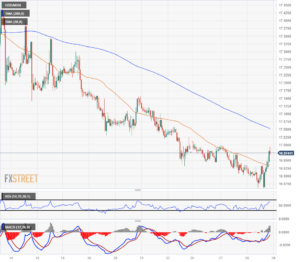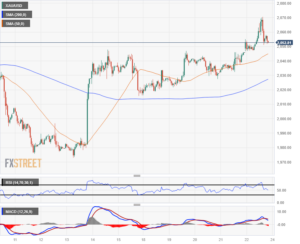- WTI Oil trades near $72 and is set to drop lower as US supply hits the export market.
- Oil looks set to sink even further as OPEC+ countries are reluctant to expand current production cuts.
- The US Dollar gears up for a third straight day of gains when measured by the US Dollar Index.
Oil prices are breaking the November low as more supply is hitting the market with US exports topping nearly 6 million barrels per day. Meanwhile, Saudi Arabia is slashing prices for Crude Exports into the Asian region. It becomes clear that what OPEC+ has reproduced as a deal isn’t enough to counterweight the effect from US Oil barrels hitting the markets.
Meanwhile, the US Dollar (USD) is firming up for a third straight day. The DXY US Dollar Index is near 104.00 and could pop higher during the week. Although US yields are declining, they are declining less rapidly than other peers, which favors the US Dollar against most other currencies.The Euro, the Chinese Yuan and Central European currencies are the biggest losers.
Crude Oil (WTI) trades at $72.32 per barrel and Brent Oil trades at $77.12 per barrel at the time of writing.
Oil news and market movers: US exports become omen for OPEC+
- US Crude exports could reach about 5.7 million barrels a day, according to ship-tracking firms Kpler and Vortexa. The Energy Information Administration (EIA) data on Wednesday could confirm these findings.
- Saudi Arabia has cut its pricing for Crude destined for the Asian market, according to a Bloomberg survey.
- Overnight, the weekly numbers from the American Petroleum Institute (API) revealed a build of 0.594 million barrels against the drawdown of 0.817 million barrels a week earlier.
- On Wednesday, the Energy Information Administration (EIA) is due to release the weekly change in US Crude stockpile. Expectations are for a draw of 2.267 million against the buildup of 1.609 million a week ago.
Oil Technical Analysis: Going down
Oil prices are sinking, breaking below November’s low. While OPEC+ faces a supply surplus, this surplus is getting bigger as the US becomes a big Oil producer. By dumping 6 million barrels per day on the global market, the excess surplus could well linger on for months before OPEC+ can finally tweak its policy in order to adjust production to liquidate the surplus. In this context, more downside is to come forOil prices until an OPEC+ decision or another catalyst takes out the surplus.
On the upside, $80.00 is the resistance to watch out for. Should crude be able to jump above that again, look for $84.00 (purple line) as the next level to see some selling pressure or profit taking. Should Oil prices be able to consolidate above there, the topside for this fall near $93.00 could come back into play.
On the downside, the soft floor near $74.00 is crumbling with a fresh low for November. This level is acting as the last line of defence before entering $70.00 and lower. Watch out for $67.00, which aligns with atriple bottom from June, as the next support level to trade at.
US WTI Crude Oil: Daily Chart
WTI Oil FAQs
WTI Oil is a type of Crude Oil sold on international markets. The WTI stands for West Texas Intermediate, one of three major types including Brent and Dubai Crude. WTI is also referred to as “light” and “sweet” because of its relatively low gravity and sulfur content respectively. It is considered a high quality Oil that is easily refined. It is sourced in the United States and distributed via the Cushing hub, which is considered “The Pipeline Crossroads of the World”. It is a benchmark for the Oil market and WTI price is frequently quoted in the media.
Like all assets, supply and demand are the key drivers of WTI Oil price. As such, global growth can be a driver of increased demand and vice versa for weak global growth. Political instability, wars, and sanctions can disrupt supply and impact prices. The decisions of OPEC, a group of major Oil-producing countries, is another key driver of price. The value of the US Dollar influences the price of WTI Crude Oil, since Oil is predominantly traded in US Dollars, thus a weaker US Dollar can make Oil more affordable and vice versa.
The weekly Oil inventory reports published by the American Petroleum Institute (API) and the Energy Information Agency (EIA) impact the price of WTI Oil. Changes in inventories reflect fluctuating supply and demand. If the data shows a drop in inventories it can indicate increased demand, pushing up Oil price. Higher inventories can reflect increased supply, pushing down prices. API’s report is published every Tuesday and EIA’s the day after. Their results are usually similar, falling within 1% of each other 75% of the time. The EIA data is considered more reliable, since it is a government agency.
OPEC (Organization of the Petroleum Exporting Countries) is a group of 13 Oil-producing nations who collectively decide production quotas for member countries at twice-yearly meetings. Their decisions often impact WTI Oil prices. When OPEC decides to lower quotas, it can tighten supply, pushing up Oil prices. When OPEC increases production, it has the opposite effect. OPEC+ refers to an expanded group that includes ten extra non-OPEC members, the most notable of which is Russia.
- SEO Powered Content & PR Distribution. Get Amplified Today.
- PlatoData.Network Vertical Generative Ai. Empower Yourself. Access Here.
- PlatoAiStream. Web3 Intelligence. Knowledge Amplified. Access Here.
- PlatoESG. Carbon, CleanTech, Energy, Environment, Solar, Waste Management. Access Here.
- PlatoHealth. Biotech and Clinical Trials Intelligence. Access Here.
- Source: https://www.fxstreet.com/news/oil-looks-set-to-break-below-70-with-us-taunting-opec-202312061145
- :has
- :is
- $UP
- 1
- 12
- 13
- 32
- 58
- 7
- a
- Able
- About
- above
- According
- acting
- adjust
- administration
- affordable
- After
- again
- against
- agency
- ago
- Aligns
- All
- also
- Although
- American
- an
- analysis
- and
- Animate
- Another
- api
- ARE
- AS
- asian
- Assets
- At
- back
- barrels
- BE
- because
- become
- becomes
- before
- below
- Benchmark
- Big
- bigger
- Biggest
- Bloomberg
- Bottom
- Breaking
- brent
- build
- by
- CAN
- Catalyst
- central
- change
- Changes
- Chart
- chinese
- Chinese Yuan
- clear
- collectively
- come
- Confirm
- considered
- consolidate
- content
- context
- could
- countries
- Crossroads
- crude
- Crude oil
- currencies
- Current
- Cut
- cuts
- daily
- data
- day
- deal
- decide
- decision
- decisions
- Declining
- defence
- Demand
- destined
- Disrupt
- distributed
- Dollar
- dollar index
- dollars
- down
- downside
- draw
- driver
- drivers
- Drop
- Dubai
- due
- during
- Dxy
- each
- Earlier
- easily
- effect
- EIA
- ends
- energy
- enough
- entering
- European
- Even
- Every
- excess
- Expand
- expanded
- expectations
- export
- exports
- extra
- faces
- Fall
- Falling
- FAQ
- favors
- Finally
- findings
- firms
- Floor
- For
- frequently
- fresh
- from
- further
- Gains
- gears
- gears up
- getting
- Global
- global market
- going
- Government
- gravity
- Group
- Growth
- High
- higher
- Hits
- hitting
- HTTPS
- Hub
- if
- Impact
- in
- includes
- Including
- increased
- Increases
- index
- indicate
- information
- instability
- Institute
- Intermediate
- International
- into
- inventory
- IT
- ITS
- jump
- june
- Key
- Last
- less
- Level
- Line
- liquidate
- Look
- LOOKS
- Losers
- Low
- lower
- major
- make
- Market
- Markets
- Meanwhile
- measured
- Media
- meetings
- member
- Members
- million
- module
- months
- more
- most
- Movers
- Nations
- Near
- nearly
- news
- next
- notable
- November
- numbers
- of
- often
- Oil
- oil price
- Omen
- on
- ONE
- opec
- opposite
- or
- order
- organization
- Other
- out
- peers
- per
- Petroleum
- pipeline
- plato
- Plato Data Intelligence
- PlatoData
- Play
- policy
- political
- pop
- predominantly
- pressure
- price
- Prices
- pricing
- producer
- Production
- Profit
- published
- Pushing
- quality
- rapidly
- reach
- referred
- refers
- refined
- reflect
- region
- relatively
- release
- reliable
- report
- Reports
- Resistance
- respectively
- Results
- Revealed
- Russia
- Sanctions
- Saudi
- Saudi Arabia
- see
- Selling
- set
- should
- Shows
- similar
- since
- slashing
- Soft
- sold
- some
- sourced
- stands
- starts
- States
- straight
- such
- supply
- Supply and Demand
- support
- support level
- surplus
- Survey
- takes
- taking
- Technical
- Technical Analysis
- ten
- texas
- than
- that
- The
- The Weekly
- their
- There.
- These
- they
- Third
- this
- three
- Thus
- tighten
- time
- to
- trade
- traded
- trades
- Tuesday
- tweak
- type
- types
- United
- United States
- Upside
- us
- US Dollar
- US Dollar Index
- US Dollars
- US oil
- US yields
- USD
- usually
- value
- via
- vice
- Watch
- weaker
- Wednesday
- week
- weekly
- WELL
- West
- What
- when
- which
- while
- WHO
- with
- within
- writing
- WTI
- WTI Crude
- yields
- Yuan
- zephyrnet













